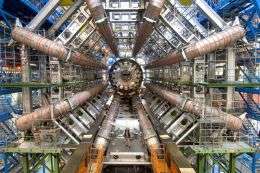July 23, 2014 weblog
IHEP in China has ambitions for Higgs factory

Who will lay claim to having the world's largest particle smasher?. Could China become the collider capital of the world? Questions tease answers, following a news story in Nature on Tuesday. Proposals for two particle accelerators could accelerate China itself as a scientific leader, upstaging the Large Hadron Collider at CERN, Europe's famous particle-physics laboratory, where the LHC is the world's largest particle collider.
China's ambition is still in the proposal stage. The country's biggest current collider, said the report, is just 240 meters in circumference. The proposal by China, said Nature, is quietly gathering momentum. Scientists at the Institute of High Energy Physics (IHEP) in Beijing, plan to build a 'Higgs factory' by 2028, a 52-kilometer underground ring, said Nature, to smash together electrons and positrons. (According to symmetry, the concept of a Higgs factory can be traced back to as early as the mid-1990s, when scientists were floating ideas for small, relatively simple machines to aid dedicated study of the hypothesized boson.) According to the news report in Nature, "The initial call is for a 52-kilometer underground ring that would smash together electrons and positrons." China hopes that it would be a stepping stone to a next-generation collider—a super proton–proton collider—in the same tunnel.
"China would like to build its electron–positron collider in the meantime, unaided by international funding if needs be, and follow it up as fast as technologically possible with the super proton collider," said Nature, by 2035.
Guido Tonelli, a particle physicist and former head of one of the two major experiments at CERN, said if China is to eventually host a super collider, the project will have to be international, according to Nature."Nobody would be able to do that alone."
IHEP director Yifang Wang said China would welcome international funding contributions for both projects; with a lot of support, the ring size could be expanded to 80 kilometers. At the same time, though, he said the country would not wait for collaborators before moving ahead. Wang added that construction could begin in as little as five years, according to Nature.
The Institute of High Energy Physics (IHEP) of the Chinese Academy of Sciences manages a number of China's major scientific facilities. They include the Beijing Electron Positron Collider, the Beijing Spectrometer, and the Beijing SynchrotronRadiation Facility (BSRF), among others. Since "the first successful e+e- collisions at the Beijing Electron Positron Collider (BEPC) in October 1988," said the IHEP site, "IHEP has become established as one of the world's major High Energy Physics (HEP) laboratories."
More information:
www.nature.com/news/china-plan … per-collider-1.15603
english.ihep.cas.cn/
Journal information: Nature
© 2014 Phys.org


















